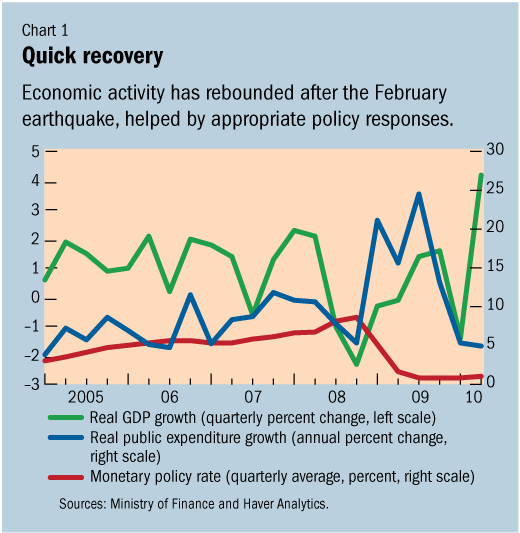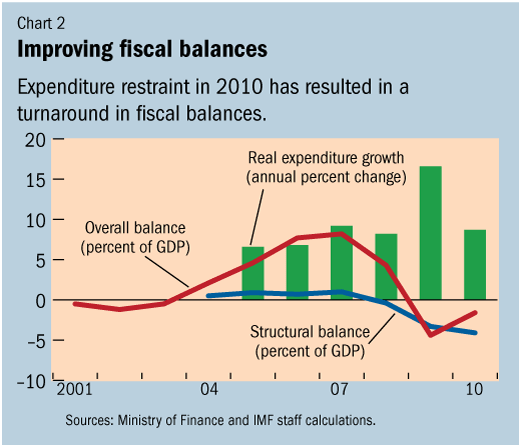
Typical street scene in Santa Ana, El Salvador. (Photo: iStock)
IMF Survey: Chile: Strong Recovery After Devastating Earthquake
September 29, 2010
- Recovery is fully under way, helped by reconstruction spending
- Challenge: reduce structural deficit while spending on reconstruction
- Further financial system and productivity-enhancing reforms needed to boost long-term growth
Seven months after February’s devastating earthquake, Chile’s economy is expected to recover strongly in 2010–11, driven by reconstruction spending and a rebuilding of inventories.

Post-earthquake reconstruction in Valparaiso, Chile. The IMF projects the economy to grow by 5 percent in 2010 (photo: Marcelo Hernandez/dpa)
Economic Health Check
The IMF, in its regular annual assessment, noted that Chile’s economy has shown remarkable resilience in the past two years. The economic recovery is fully under way, helped by appropriate policy responses to the two large adverse shocks—the earthquake and last year’s recession.
In early 2010 the Chilean economy was poised for a strong recovery. But on February 27, 2010 the country suffered a massive earthquake. Reconstruction costs were estimated to be close to US$30 billion. Yet, the economy rebounded in the second quarter of 2010 after a short contraction (see Chart 1).
Based on these trends, the IMF projects that the Chilean economy will grow by 5 percent in 2010 and 6 percent in 2011. “Strong private consumption and large public and private investment, including on inventories, are expected to sustain domestic demand growth,” the report said.

Reducing the structural deficit
Fiscal policy played a critical countercyclical role, drawing on the public savings accumulated prior to the global crisis (see Chart 2). The 2009 fiscal stimulus helped support an early recovery of economic activity. And after taking office in March 2010, the new administration put in place an ambitious earthquake reconstruction program.
Now in the recovery phase, the Chilean authorities are committed to finish their term in office with a sharp reduction in the structural deficit (with revenues measured at potential output and long-term copper prices). They intend to achieve a structural deficit of 1 percent by 2014, even after allowing for the spending needed to support the earthquake reconstruction efforts.
To achieve this goal, they are prepared to drastically trim the growth of nonessential expenditure, reallocate spending, temporarily increase taxes, and carry out some additional borrowing. In late July, Chile placed 10-year bonds worth $1 billion with a spread of only 90 basis points and peso-denominated debt worth $500 million at a 5.5 percent interest rate in international financial markets, signaling strong market confidence that economic stability will be preserved.

The IMF report welcomes the government’s decision to review the fiscal rule, which allows automatic stabilizers to work freely during the business cycle. Areas for improvement include making the calculation of the structural balance more transparent and introducing an explicit escape clause to allow for discretionary countercylical policy in the case of large shocks. It would also be important to set fiscal policy in a medium term context that extended beyond the term of the current government.
Tightening monetary policy
As the economy rebounds, the central bank has started raising interest rates. As of mid-September, the policy interest rate had been increased to 2.5 percent, and the central bank stands ready to raise interest rates as necessary to keep inflation in line with the target of 3 percent. Monetary policy enjoys strong credibility, as the market expects inflation to gradually decline to the target within the 24-month policy horizon of the central bank.
But the challenge for monetary policy is that rising domestic interest rates and a recovering economy could attract more capital inflows, leading to a further appreciation of the Chilean peso. The IMF report supported the central bank’s approach to rely on exchange rate flexibility as the first line of defense to discourage excessive capital inflows.
Further financial system strengthening
IMF staff agreed with the authorities that domestic credit risks would diminish further as the recovery firms up. The earthquake is expected to have a limited temporary impact on credit risk in the affected zones, as indicated in the latest financial stability report of the central bank. However, for the banking system as a whole, this effect is being offset by the rebound of economic activity and lower unemployment.
The authorities also remain committed to continue financial sector reforms. These reforms are intended to further strengthen the prudential framework and deepen domestic capital markets, which should be beneficial for productivity growth.
The third capital market reforms law, approved by Congress in May 2010, broadens the universe of authorized financial instruments, including exchange-traded funds and mortgage bonds; facilitates the process of securitization; and extends tax exemptions on selected fixed income instruments to foreign institutional investors. In addition, the government is developing another set of reforms to improve further the liquidity of financial markets and update the institutional framework, especially in the areas of consolidated supervision and corporate governance of the financial supervisors.
Enhancing productivity growth
To create the incentives for faster growth in productivity, the government is planning reforms aimed at increasing competition, facilitating the entry of new firms, making credit more accessible to small and medium-enterprises, and improving bankruptcy regulations. It also plans to establish a specialized stock market to facilitate initial public offerings for start-ups and increase the availability of venture capital.
IMF staff agreed with the authorities that replacing the current high severance payment system with a more comprehensive unemployment insurance scheme could help increase labor market mobility and encourage greater investment in education and on-the-job training. Increasing the share of skilled workers in the labor force could also help reduce income inequality.







